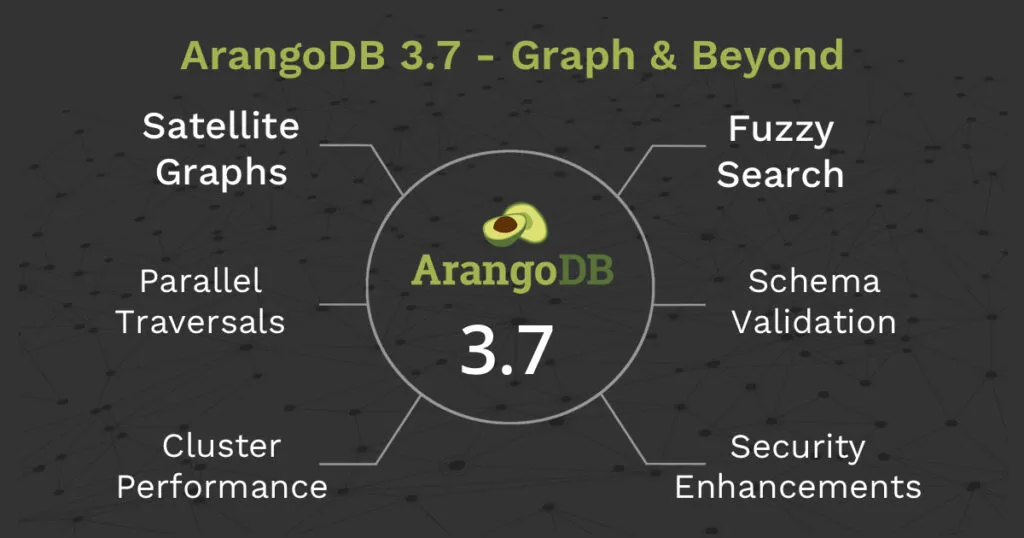ArangoDB 3.7 – A Big Step Forward for Multi-Model
Estimated reading time: 7 minutes

When our founders realized that data models can be features, we at ArangoDB set ourselves the big goal of developing the most flexible database. With today’s GA release of ArangoDB 3.7, the project reached an important milestone on this journey.
(more…)Do Graph Databases Scale? Yes? No? Let’s see!
Estimated reading time: 10 minutes
Graph Databases are a great solution for many modern use cases: Fraud Detection, Knowledge Graphs, Asset Management, Recommendation Engines, IoT, Permission Management … you name it.
All such projects benefit from a database technology capable of analyzing highly connected data points and their relations fast – Graph databases are designed for these tasks.
But the nature of graph data poses challenges when it comes to *buzzword alert* scalability. So why is this, and are graph databases capable of scaling? Let’s see…
(more…)AWS Neptune: A New Vertex in the Graph World — But Where’s the Edge?
At AWS Re:Invent just a few days ago, Andy Jassy, the CEO of AWS, unveiled their newest database product offerings: AWS Neptune. It’s a fully managed, graph database which is capable of storing RDF and property graphs. It allows developers access to data via SPARQL or java-based TinkerPop Gremlin. As versatile and as good as this may sound, one has to wonder if another graph database will solve a key problem in modern application development and give Amazon an edge over its competition. Read More
Performance analysis with pyArango: Part III Measuring possible capacity with usage Scenarios
AQL Optimizer Improvements in ArangoDB 2.8
With the 2.8 beta phase coming to an end it’s time to shed some light on the improvements in the 2.8 AQL optimizer. This blog post summarizes a few of them, focusing on the query optimizer. There’ll be a follow-up post that will explain dedicated new AQL features soon. Read more
AQL Function Speedups: ArangoDB 2.8 Enhancements
While working on the upcoming ArangoDB 2.8, we have reimplemented some AQL functions in C++ for improved performance. AQL queries using these functions may benefit from using the new implementation of the function.
The following list shows the AQL functions for which a C++ implementation has been added in 2.8. The other C++-based AQL function implementations added since ArangoDB 2.5 are also still available. Here’s the list of functions added in 2.8: Read more
Using Multiple Indexes per Collection in ArangoDB
The query optimizer in ArangoDB 2.8 has been improved in terms of how it can make use of indexes. In previous versions of ArangoDB, the query optimizer could use only one index per collection used in an AQL query. When using a logical OR in a FILTER condition, the optimizer did not use any index for the collection in order to ensure the result is still correct.
This is much better in 2.8. Now the query optimizer can use multiple indexes on the same collection for FILTER conditions that are combined with a logical OR. Read more
Index Speedups in ArangoDB 2.8: Enhancements
The upcoming 2.8 version of ArangoDB will provide several improvements in the area of index usage and query optimization.
First of all, hash and skiplist indexes can now index individual array values. A dedicated post on this will follow shortly. Second, the query optimizer can make use multiple indexes per collection for queries with OR-combined filter conditions. This again is a subject for another post. Third, there have been some speed improvements due to changes in the general index handling code. This is what this post is about. Read more
Benchmark: PostgreSQL, MongoDB, Neo4j, OrientDB and ArangoDB
In this blog post – which is a roundup of the performance blog series – I want to complete the picture of our NoSQL performance test and include some of the supportive feedback from the community. First of all, thanks for all your comments, contributions and suggestions to improve this open source NoSQL performance test (Github). This blog post describes a complete overhaul of the test with no need to read all the previous articles to get the picture – have a look at the appendix below to get all the details on hard- and software, the dataset and tests, used in this NoSQL performance comparison. Read more
Throughput Enhancements: Boosting ArangoDB Performance
We’ve recently been working on improving ArangoDB’s throughput, especially when using the ArangoDB’s interface.
In this post, I will show some of the improvements already achieved, though the work is not yet finished. Therefore, the results shown here are still somewhat preliminary.
We wanted to measure improvements for ArangoDB’s HTTP interface, and so we used wrk as an external HTTP load generator.
During the tests, wrk called some specific URLs on a local ArangoDB instance on an otherwise idle machine. The test was run with ArangoDB 2.6 and devel. The ArangoDB instances were started with their default configuration.
wrk was invoked with varying amounts of client connections and threads, so the tests cover serial and concurrent/parallel requests:
bash invoking wrk
wrk -c $CONNECTIONS -t $THREADS -d 10 $URL
The number of connections ($CONNECTIONS) and threads ($THREADS) were both varied from 1 to 8. wrk requires at least as many connections as threads.
Get the latest tutorials,
blog posts and news:
Thanks for subscribing! Please check your email for further instructions.
 Skip to content
Skip to content 